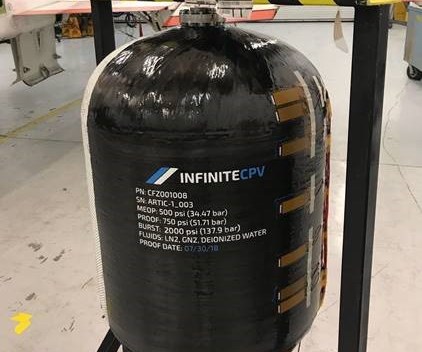Graphene technology enables composite cryogenic pressure vessels
Infinite Composites incorporates Applied Graphene Materials’ graphene technology into two resin systems for cryogenic pressure vessels being considered for NASA missions.

Source | Applied Graphene Materials
Applied Graphene Materials (AGM, Cleveland, U.K.), producer of specialty graphene materials, and Infinite Composites Technologies (Tulsa, Okla., U.S.), a designer, developer and manufacturer of composite pressure vessels, have together developed a composite material technology suitable for specific space applications.
Infinite Composites has successfully incorporated AGM’s graphene technology into two resin systems for cryogenic pressure vessels being considered for use in multiple NASA spaceflight missions, including materials on the International Space Station Experiments (MISSE), Artemis and Lunar Gateway. The achievement follows extensive product development and a rigorous testing program as part of a long-standing relationship between AGM and Infinite Composites. Subject of a recent Small Business Innovation Research (SBIR) NASA award, the Infinite Composites team is focused on the continuing development of their cryogenic pressure vessel systems for space applications.
The addition of AGM’s graphene technology has helped enable the tanks to complete their first liquid oxygen loading test at -300ºF pressurized to 600 psi. Analysis of the composite structure using scanning electron microscope techniques indicated that the addition of the graphene technology eliminated nearly all microfractures in resin samples after exposure to the extreme cryogenic environment versus the control samples.
These results demonstrate the ability of AGM's technology to effectively manage fracture toughness and robustness of composite structures for long-term durability.
“We are fortunate to have a great company like AGM as a part of the Infinite Composites supply chain for innovative graphene materials,” says Matt Villarreal, founder and CEO of Infinite Composites. “The customized dispersed graphene materials that are integrated into our 2 resin systems enable ease of use and in turn ensure quality, repeatable structures to be built, where performance is critical to the market we operate in.”
“This result is a real testament to our years of collaboration with the [Infinite Composites] team to deliver significant performance enhancements for their specific application,” says Adrian Potts, CEO of Applied Graphene Materials. “AGM is proud to be working with the Infinite Composites team on this exciting development effort to support the future of space flight and sustainable transportation. In demanding applications such as this where failure is not an option, it is pleasing that our graphene dispersions are driving the performance of composite materials.”
Related Content
-
NCC reaches milestone in composite cryogenic hydrogen program
The National Composites Centre is testing composite cryogenic storage tank demonstrators with increasing complexity, to support U.K. transition to the hydrogen economy.
-
Composites end markets: Batteries and fuel cells (2024)
As the number of battery and fuel cell electric vehicles (EVs) grows, so do the opportunities for composites in battery enclosures and components for fuel cells.
-
Infinite Composites: Type V tanks for space, hydrogen, automotive and more
After a decade of proving its linerless, weight-saving composite tanks with NASA and more than 30 aerospace companies, this CryoSphere pioneer is scaling for growth in commercial space and sustainable transportation on Earth.
















